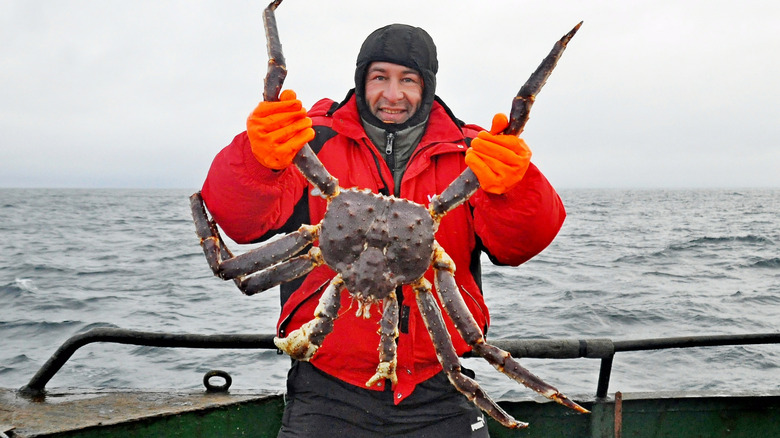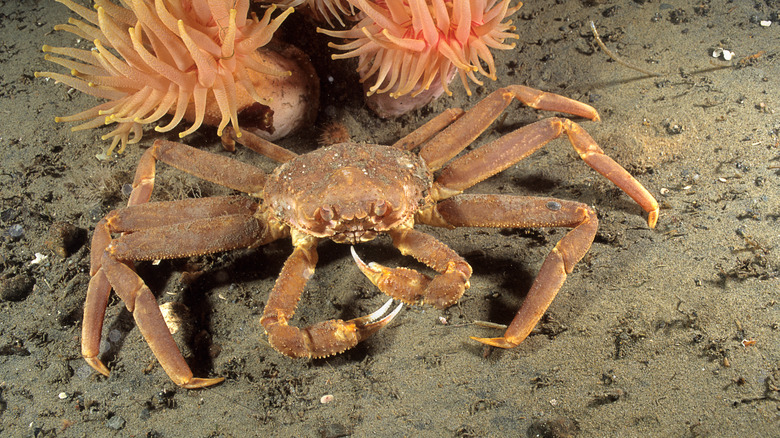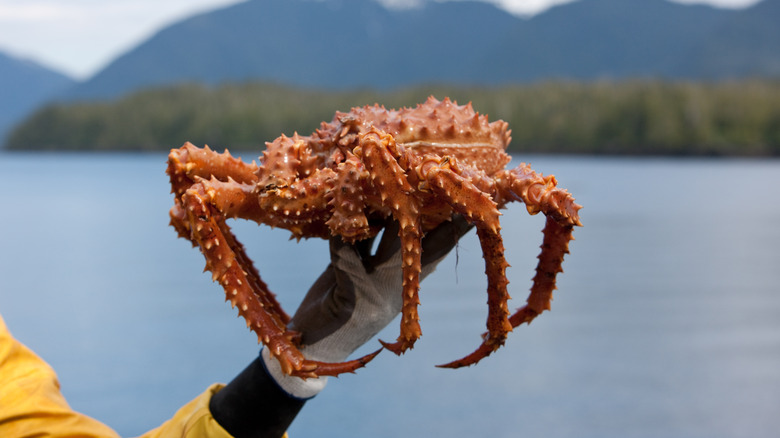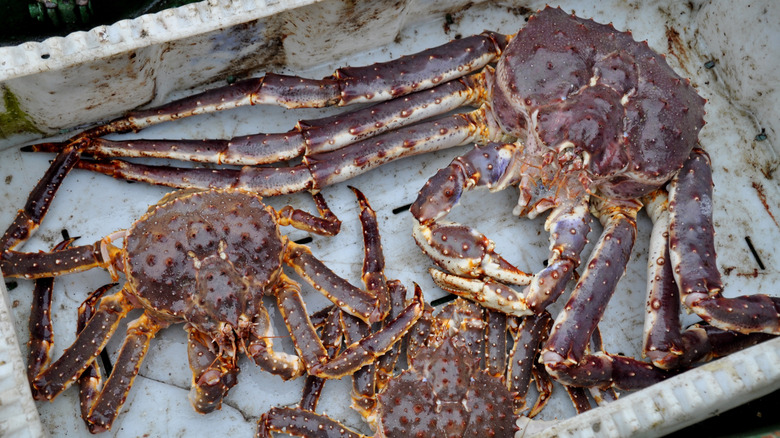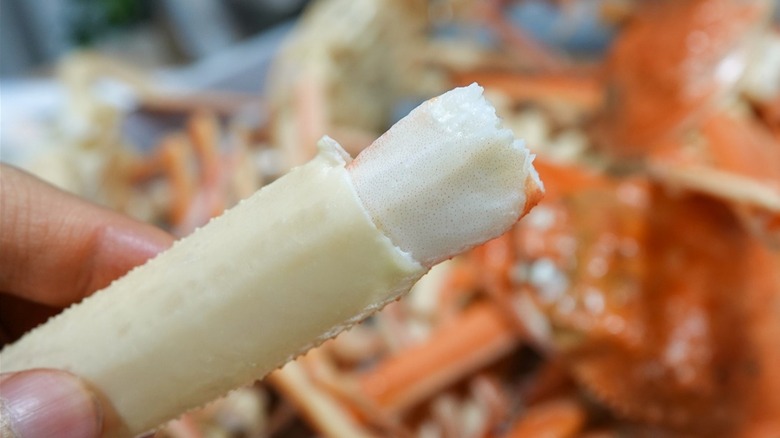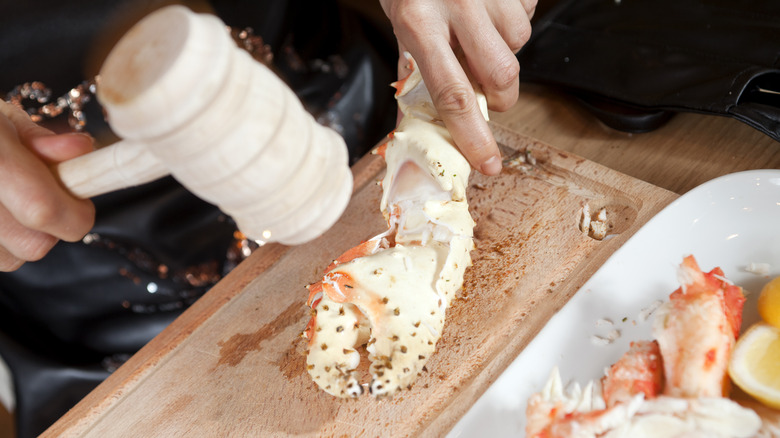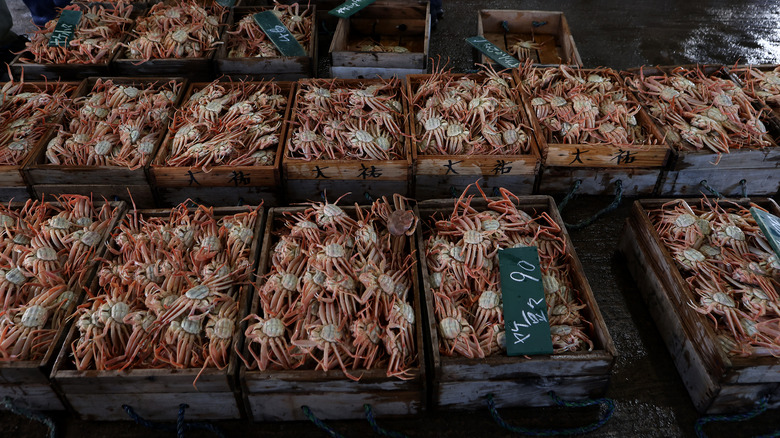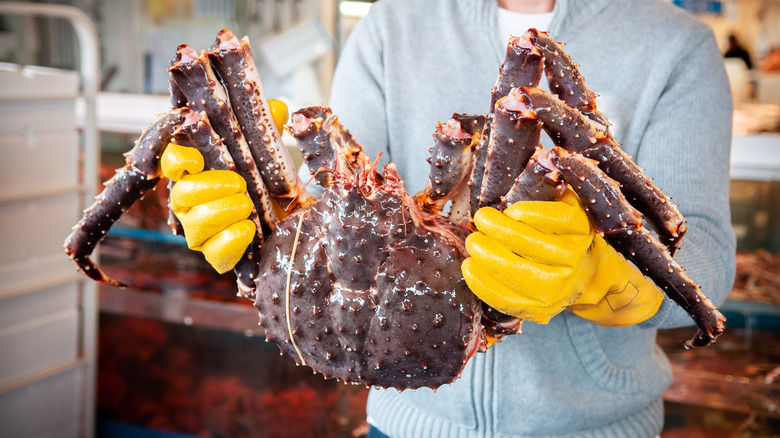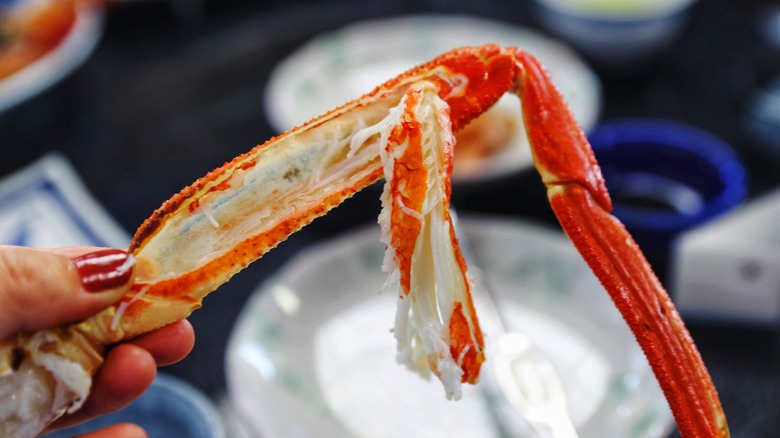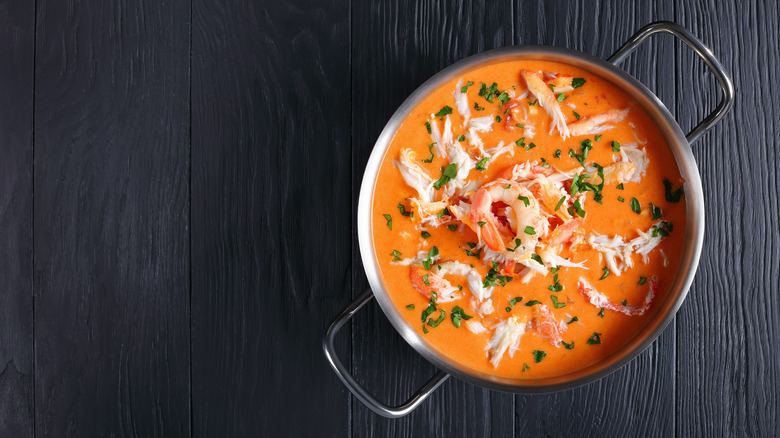What's The Difference Between Snow Crab And King Crab?
Recently, The National Fisheries Institute released data that revealed crab as the eighth most popular seafood in the United States in 2021. Six species make up the majority of crab found on the American market: king crab, snow crab, blue crab, stone crab, Dungeness crab, and Jonah crab. Although each of these species has its own characteristics — both culinary and biological — many people are unaware of the differences between them.
This is especially true of two sought-after varieties, king crab and snow crab, which are prized for their leg meat. Both feature on menus across the U.S., and snow crab is a favorite of all-you-can-eat buffets while king crab is a classier option, stocked by up-market restaurants. That their legs are regularly enjoyed by the American public should not overshadow the many differences between the two. After all, these two crabs are quite distinct and how we approach them should reflect this.
What is snow crab?
Snow crab (Chionoecetes opilio) is a type of crab prevalent in the cold waters of the Northern Hemisphere. It can be found on both the Atlantic and Pacific coastlines of North America and has a pronounced, spider-like shape with eight long legs and two claws.
The snow crab's name comes from the color of its cooked flesh, which takes on a brilliantly white hue. The vast majority of this meat comes from the snow crab's legs which are the part of the animal that is predominantly enjoyed by the American public. Although also edible, snow crab claws and the meat from its body are eaten less often, due to the lower quantity of meat and abundance of organs respectively.
Snow crabs sourced from the Bering Sea off the coast of Alaska, sometimes known as Alaska snow crabs, are seen as being particularly desirable. However, a shocking population decline between 2018 and 2022 saw nearly 10 billion crabs disappear from this stock. This has affected the availability of Alaska snow crab and forced consumers to eat snow crab from other waters, including those imported from Canada.
What is king crab?
While there are around 40 different species of king crab globally, only three are harvested from the waters surrounding the United States. These are red king crab (Paralithodes camtschaticus), blue king crab (Paralithodes platypus), and golden king crab (Lithodes aequispinus). The red king crab — often known simply as king crab — is the most commercially desirable of these as it's the largest of all harvested crabs, so this article will focus on it specifically.
Four distinct stocks of king crab are found off the coast of Alaska, and all have suffered from dwindling populations in recent years. As a result, with populations reaching record a record low, the 2021-2022 winter fishing season for king crab was canceled. Interestingly, though, stocks found in other cold oceans are thriving. Off the coast of Norway, where the species is invasive, king crabs abound and have become an integral part of the fishing industry.
Wherever they are found across the world, king crabs have six legs and two claws, making them distinct from other crabs which have eight legs. Their claws are also different sizes, with a larger one for crushing and a smaller, more dexterous one. Their shells differ from snow crabs too, with a robust carapace covered in a series of spikes.
King crabs are larger
The most obvious difference between king crabs and snow crabs is their size. As the largest commercially caught crabs, king crabs can grow to monstrous proportions, reaching a weight of 24 pounds. By comparison, snow crabs are significantly smaller. Males only attain a weight of around three pounds, while females grow to about half this size.
Despite the huge disparity in weight, the two species of crab have a smaller divergence in their leg spans because king crabs are known for having short, thick legs whereas snow crabs are famed for thin, long legs that make great eating. Generally, king crabs have a leg span of up to five feet, while snow crabs have a leg span of three feet. That being said, king crab legs and claws contain much more meat than snow crab legs and claws. Snow crab legs usually weigh between five and eight ounces. An average meat yield of approximately 17% means each leg only contains between 0.85 and 1.36 ounces of meat. King crab legs routinely weigh between eight and 32 ounces. With an average yield of 25%, that means customers can expect each to give anything between two and eight ounces of meat.
Snow crab meat tastes briny
It's not just size that distinguishes king crab meat from snow crab meat, but flavor too. The former is celebrated for a delicate sweetness and a meaty texture, both of which are similar to lobster (although crab is slightly sweeter). Snow crab also has a distinct sweetness but this is accompanied by a unique briny, savory flavor. As a result, the flavor profile of snow crab meat is much more complex than that of king crab.
In terms of texture, the large chunks of king crab meat are incredibly succulent. This means it's well-suited to being sliced and incorporated into dishes including risotto, stews, or pasta. Snow crab meat is known for being more fibrous, especially in the animal's claws. This unique combination of flavor and texture makes snow crab a fantastic choice for making crab cakes, as the resulting dish will be both structurally sound and immensely flavorful.
Snow crab carapaces are weaker
While the meat of both snow crabs and king crabs can be used in a variety of dishes, both animals are most commonly served with legs left intact and still encased in the animal's carapace. A complicated and messy eating process often results. While a degree of splattering and crab carapace shattering is unavoidable, breaking down snow crab legs is significantly easier. This is because the shell of this animal is much weaker than that of the king crab. In fact, diners often use their bare hands to remove the meat from snow crab legs — although this can be difficult if the legs have been overcooked, which can soften the shell and make it more difficult to crack open.
The spiny, strong carapace that covers the king crab's legs proves more stubborn. To avoid injuring their hands, diners are advised to crack the carapace using a specially designed cracker. If one is not to hand, a nutcracker, the side of a knife, or even a mallet can be used instead.
Snow crab is more readily available
Generally, the total catch of snow crabs is much larger than that of king crabs; it's not uncommon for fishing companies to catch over 40 million pounds of snow crab off the coast of Alaska alone. For comparison, this same area has set a limit of 2.1 million pounds for the upcoming king crab season. As they're more abundant, the snow crab season is much longer than the king crab season, typically spanning from October to April, whereas the 2023/24 king crab season will only last three months. All of this means it's much easier for consumers to find, purchase, and enjoy Alaskan snow crab than Alaskan king crab.
Snow crab caught in other oceans is even more abundant. In January 2023 alone, the United States imported 1,313 tonnes of snow crab from Canada. On the other hand, importing king crab has been a challenge ever since President Joe Biden banned the import of seafood from Russia, a country that boasts 94% of the global king crab quota. As a result, snow crab — both fresh and frozen — is much easier for consumers to find in stores across the U.S.
King crab is usually more expensive
As snow crab is more abundant than king crab, it should come as no surprise that it's also cheaper. A high global snow crab quota of 160,000 tonnes, coupled with a large amount of leftover 2022 stock has seen snow crab prices plummet in the United States from $19 per pound in January 2022 to $7.50 one year later. By comparison, the usual price for king crab ranges from $30-50 per pound. In 2022, after a year with no open king crab season in Alaska, the price was even higher, approaching $90 per pound.
The only instance when snow crab proved significantly more expensive than king crab was in Japan in 2019. At the beginning of the 2019 season a single, 2.7-pound snow crab was auctioned off for a massive $46,000. The huge price paid did not only reflect the quality of the crab but also a Japanese tradition wherein extravagantly large purchases are made to celebrate the opening of a season. Thankfully, regular consumers will never be expected to pay anything approaching this much for a snow crab.
King crab meat contains more sodium
There are two instances where the nutritional value of king crab meat and snow crab meat differ greatly. The first is sodium. A 100-gram portion of king crab contains 1,070 milligrams of sodium, significantly more than the 393 milligrams found in the same portion of snow crab meat. As a result, those following low-sodium diets should opt for snow crab over king crab wherever possible. The second big difference is calcium levels. At 134 milligrams per 100-gram serving, snow crab has more than double the calcium found in the same-sized serving as king crab.
Aside from these two points, king crab meat and snow crab meat are nutritionally similar. Both are an excellent source of protein — around 18 grams per 100-gram serving — and contain only minimal amounts of fat. Meat from the two animals also contains an abundance of minerals including zinc, potassium, and iron.
You can substitute one for another in recipes
In both the ocean and dining room, king crabs and snow crabs have their differences, but this doesn't mean that cooks can't substitute one for the other. The best place to substitute one for another is in dishes where they're cooked and served amongst a host of other ingredients, for example in a crab casserole or bisque. During the cooking process, and due to the vying tastes of so many ingredients, the more subtle nuances in the crab's flavor are lost. As a result, diners are not likely to realize that they are eating snow crab instead of king crab or vice versa. This is doubly the case when the finished dish combines crab meat with spicy ingredients.
An instance where a substitute should not be made is when the crab legs are lightly steamed and served whole. In this situation, the different flavors and textures inherent to each crab type will be noticeable. What's more, the much higher price of king crab could see a casual family meal costing hundreds of dollars more than it usually does. Finally, substituting king crab legs for snow crab legs necessitates the use of specialist equipment, like crackers, to break them apart. If you don't own these, it's better to avoid making the swap.
